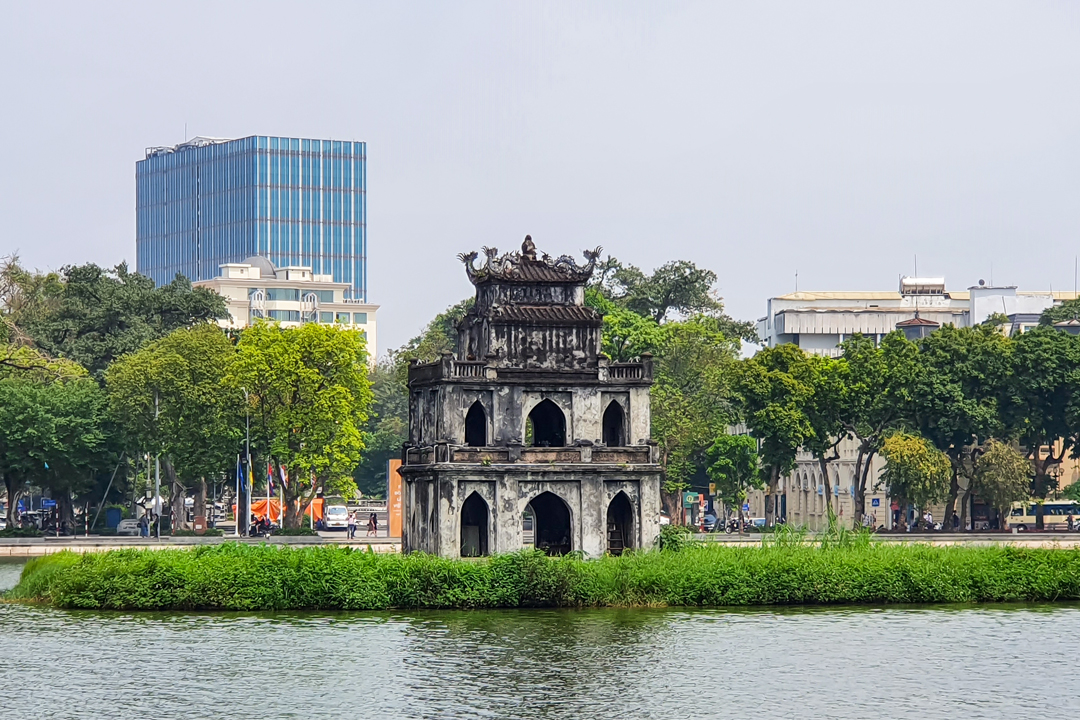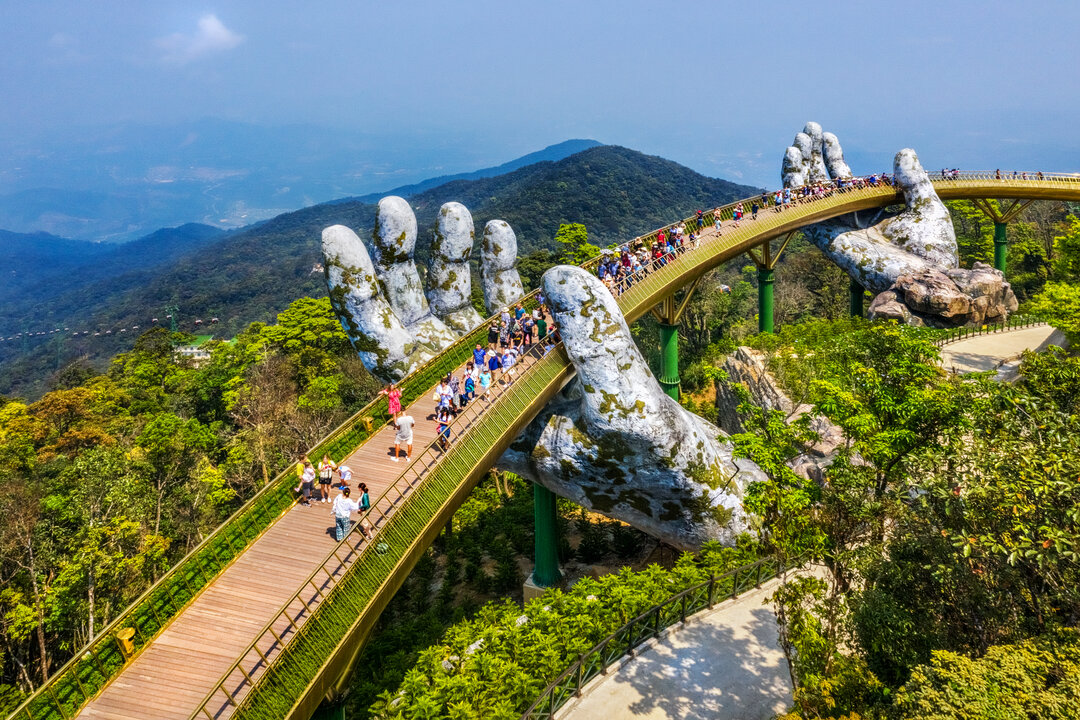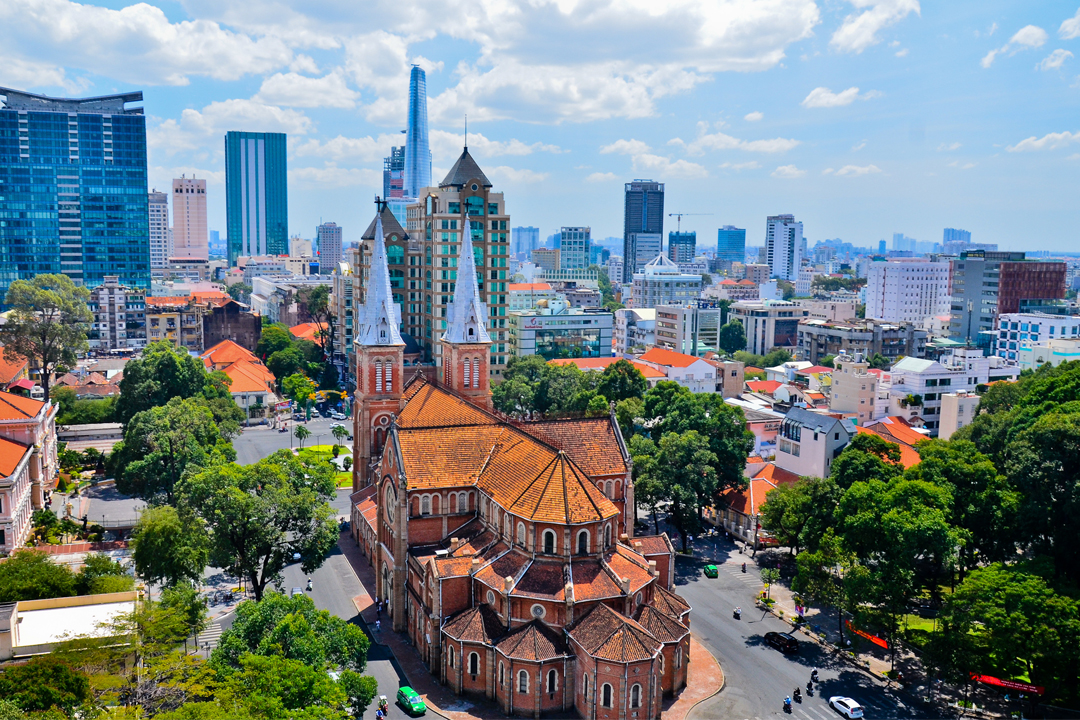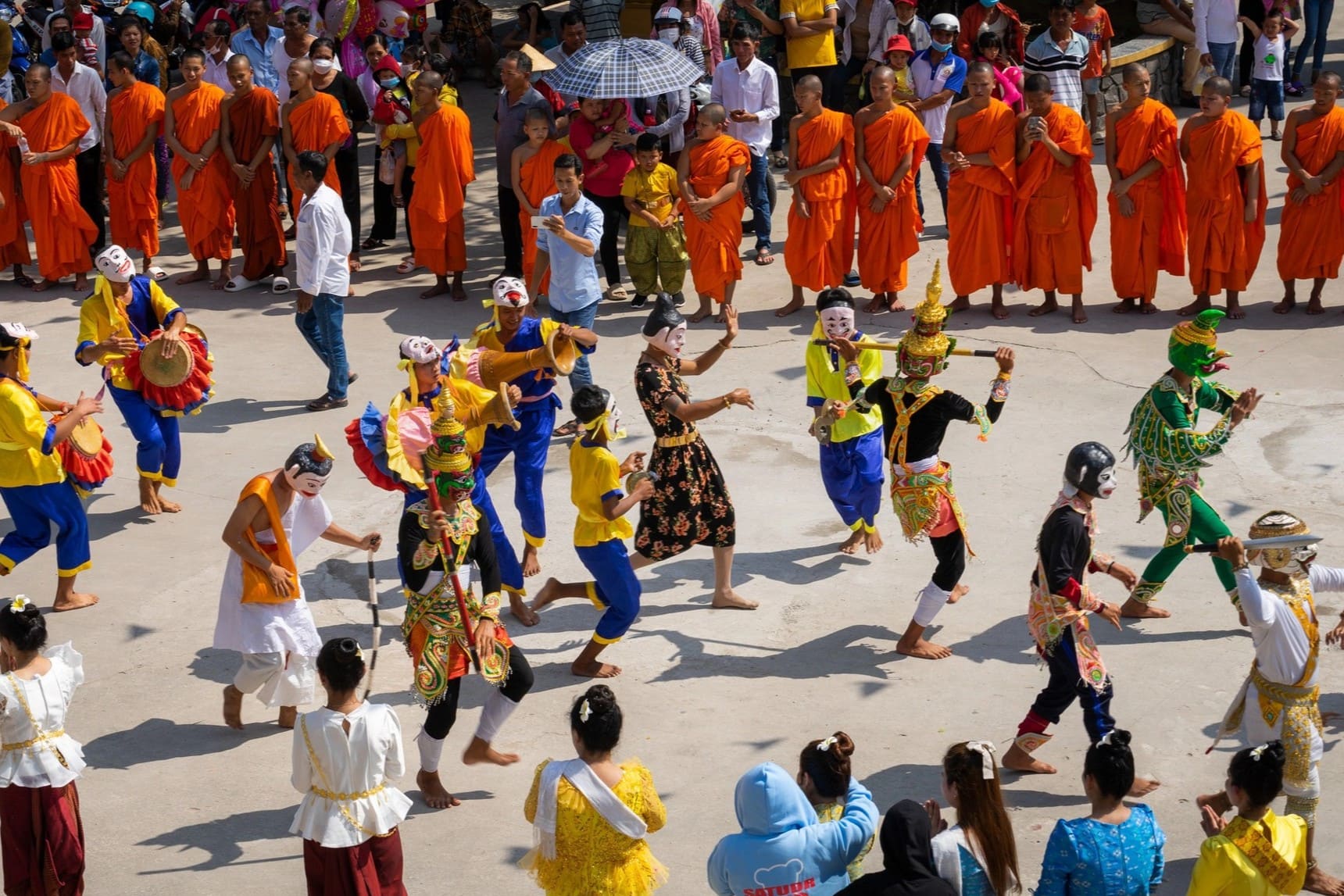Imperial Citadel of Hue: History, Architecture, Things To Do & Travel Guide
Located in the heart of Hue, Vietnam’s ancient capital, the Imperial Citadel unfolds as a symbol of cultural pride and royal legacy. Constructed in the early 19th century by Emperor Gia Long, the citadel was inspired by Eastern philosophy and French military design, combining spiritual harmony with strategic defense. Within its moats and fortified walls lie palaces, shrines, pavilions, and ceremonial halls that once served as the political, cultural, and spiritual nucleus of the Nguyen Dynasty. Spanning a vast 520 hectares on the north bank of the Perfume River, this UNESCO World Heritage Site holds stories from the Nguyen Dynasty's inception in 1802 until its conclusion in 1945.
Today, Hue Citadel thrives as a living museum where history meets modern travel. The site offers immersive experiences for culture seekers, architecture enthusiasts, and photographers alike. The Imperial Citadel of Hue invites you to journey through its majestic gates and witness the soul of Vietnam's last empire. This article of GTrip delves into the grandiose structures and hidden corners of the Hue Citadel, offering a tourist guide and a detailed journey through an emblem of imperial power.
History of the Imperial Citadel of Hue
The Imperial Citadel of Hue is located at Phu Hau, Hue City, and stands as a powerful symbol of Vietnam's imperial history and cultural heritage. Its origins trace back to the dawn of the Nguyen Dynasty, which emerged victorious in 1802 after a turbulent period of civil war and rebellion. Emperor Gia Long, the dynasty’s founder, sought not only to unify the country but also to establish a centralized power that would reflect the legitimacy and strength of his rule. In pursuit of this vision, he chose Hue as the imperial capital, shifting the political heart of Vietnam from the northern city of Thang Long, now Hanoi, to the central region.
Construction of the Imperial Citadel of Hue began in 1804, and its location was carefully selected for both strategic and symbolic reasons. Nestled on the north bank of the Perfume River, Hue offered a geographically central position that connected the northern and southern parts of the country. The site also provided natural defenses and was believed to possess favorable geomantic properties according to feng shui principles, which deeply influenced Vietnamese urban planning and imperial ideology.
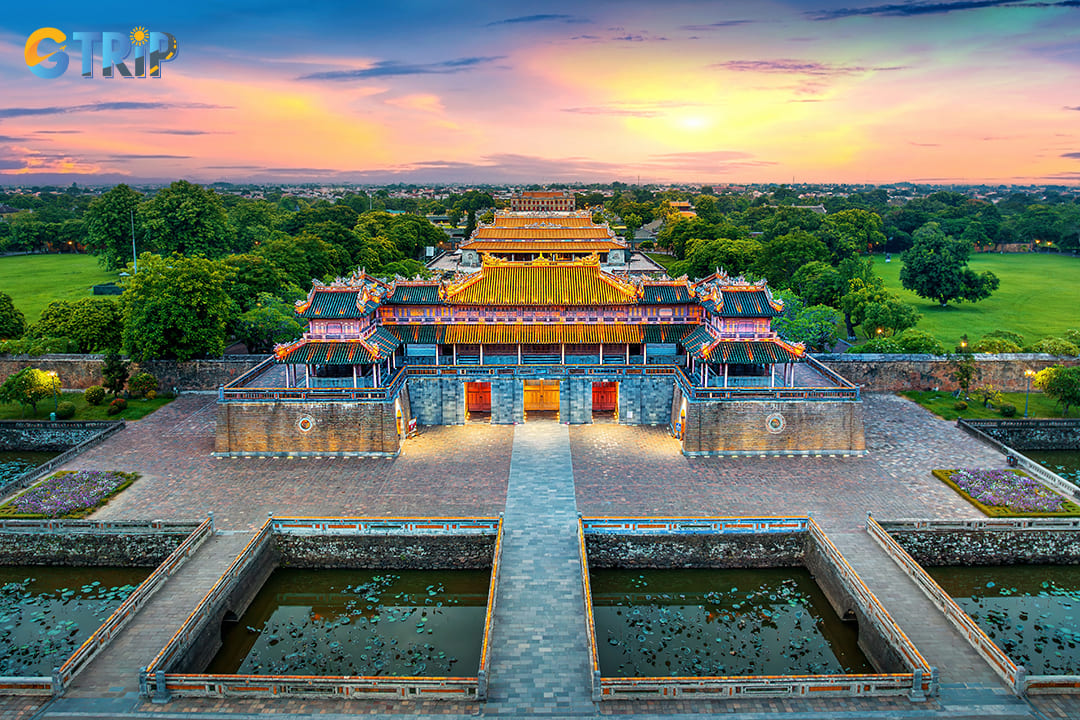
The Imperial Citadel of Hue stands as a powerful symbol of Vietnam's imperial history and cultural heritage
The architecture of the citadel was a remarkable blend of traditional Vietnamese design and Western military engineering. Inspired by the Vauban-style fortresses of Europe, the layout featured thick defensive walls, bastions, and a moat, demonstrating a sophisticated understanding of contemporary military architecture. At the same time, the Citadel preserved the elegance and symbolism of Vietnamese imperial structures. Key landmarks within the complex, such as the Ngo Mon Gate, Thai Hoa Palace, and the Forbidden Purple City, showcased intricate woodwork, royal iconography, and harmonious spatial arrangements that emphasized the power and divinity of the emperor.
For nearly a century and a half, the Imperial Citadel of Hue served as the political and cultural nucleus of the Nguyen Dynasty. From here, emperors ruled over a unified Vietnam, overseeing the implementation of Confucian-inspired governance, promoting education, and fostering the arts. Hue became a center of learning and refinement, attracting scholars, poets, and artisans who contributed to its flourishing intellectual and cultural life.
Even after the abdication of the last Nguyen emperor, Bao Dai, in 1945, the legacy of the Citadel endured. Though it suffered significant damage during wars and periods of neglect, the Imperial Citadel of Hue remains a potent reminder of Vietnam’s dynastic era. It was recognized as a UNESCO World Heritage Site in 1993, and ongoing efforts by the Hue Monuments Conservation Centre continue to preserve its historical and architectural significance. The history of the Imperial Citadel of Hue is not merely a story of stone and structure but a reflection of Vietnam’s journey through unity, tradition, and transformation.
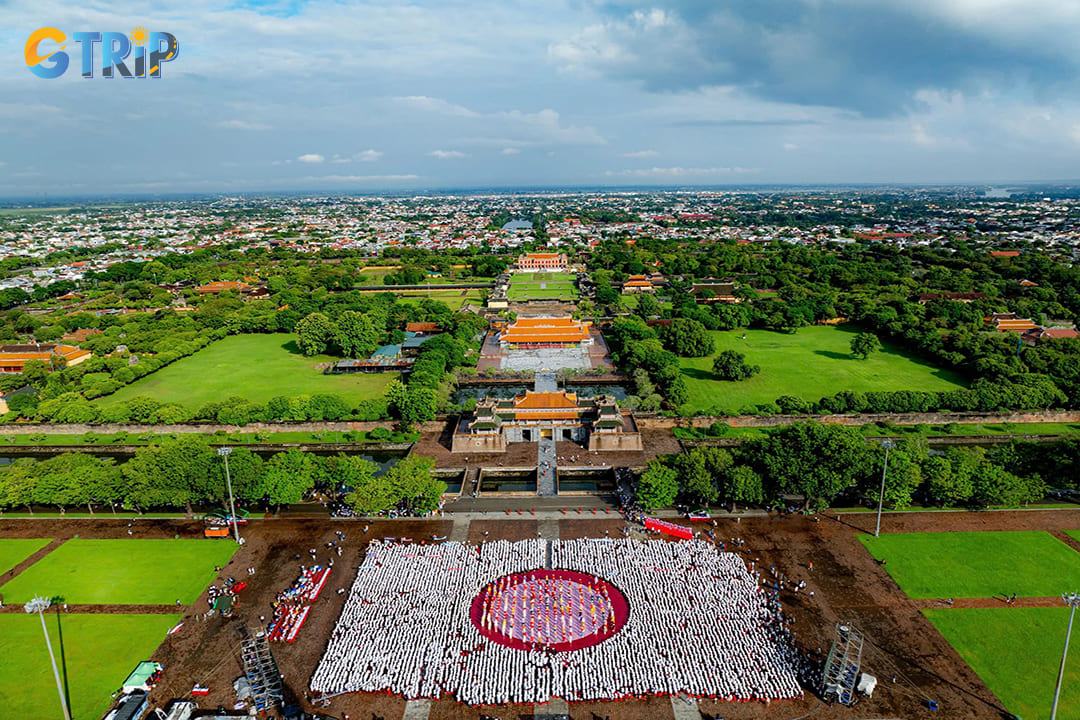
The Imperial Citadel of Hue was recognized as a UNESCO World Heritage Site in 1993
The architecture of the Imperial Citadel of Hue
The Imperial Citadel of Hue is a remarkable architectural and military complex that exemplifies a unique fusion of Eastern tradition and Western defensive ingenuity. It was constructed between 1805 and 1832 under the reigns of Emperor Gia Long and Emperor Minh Mang. The citadel follows a near-square layout with a perimeter of over 10 kilometers and covers approximately 520 hectares. Its layout was heavily influenced by the French Vauban style of star-shaped fortresses, while remaining deeply rooted in Eastern geomantic principles. The front of the citadel gently curves along the meandering Perfume River, enhancing both aesthetics and defense.
The structure consists of three concentric enclosures aligned on a north-south axis:
The Outer Citadel (Kinh Thanh)
- Nearly 10 km in circumference, with 5-meter-high walls and 21 meters in thickness.
- Constructed with compacted earth and bricks, featuring 24 bastions for enhanced defense.
- Surrounded by a 7 km-long moat, serving both as protection and a transport route.
- Contains 13 gates: 10 opening to the outside, 1 internal gate, and 2 waterway gates.
The Imperial City (Hoang Thanh)
- Rectangular in shape, covering around 37.5 hectares with a 2,356-meter perimeter.
- Walls are over 4 meters tall and 1 meter thick.
- Served as the center of administration, ceremony, and governance.
- Includes four main gates and numerous palaces, temples, and halls.
The Forbidden Purple City (Tu Cam Thanh)
- The innermost and most private area, covering over 9 hectares.
- Walls measure 3.1 meters high and 0.72 meters thick.
- Functioned as the living quarters of the emperor, queen, and royal concubines.
- Enclosed by its own set of seven gates, emphasizing exclusivity and control.
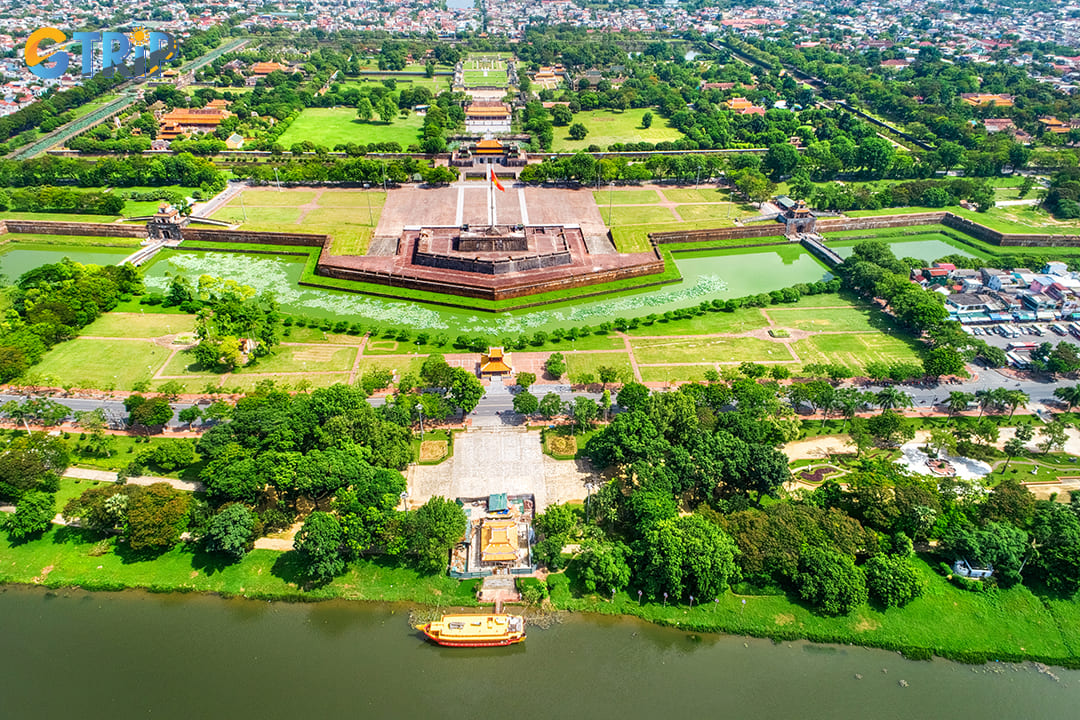
The Imperial Citadel of Hue is a remarkable architectural and military complex that exemplifies a unique fusion of Eastern tradition and Western defensive ingenuity
Here is the list of gates in the Imperial Citadel:
| Gate name (English) | Vietnamese name | Alternative/Common name | Notes |
|---|---|---|---|
| Meridian Gate | Ngo Mon | South Gate | Main entrance, for the King |
| Chanh Bac Gate | Chanh Bac Mon | Hau Gate, Mang Ca Gate | North Gate, rear of the citadel |
| An Hoa Gate | Cua An Hoa | North West Gate | Named after the nearby village |
| Chanh Tay Gate | Chanh Tay Mon | West Gate | |
| Huu Gate | Huu Mon | Tay Nam Gate, South West Gate | |
| Chanh Nam Gate | Chanh Nam Mon | Nha Do Gate, South Gate | Near Royal Arsenal |
| Quang Duc Gate | Quang Duc Mon | Sap Gate | Collapsed in 1953, rebuilt |
| The Nhon Gate | The Nhon Mon | Ngan Gate | For the royal family |
| Thuong Tu Gate | Thuong Tu Mon | South East Gate | Near the royal stables |
| Chanh Dong Gate | Chanh Dong Mon | Dong Ba Gate, East Gate | |
| Ke Trai Gate | Ke Trai Mon | North East Gate | |
| Tay Thanh Thuy Quan | Tay Thanh Thuy Quan | West Water Gate | Waterway gate |
| Dong Thanh Thuy Quan | Dong Thanh Thuy Quan | East Water Gate | Waterway gate |
| Tran Binh Mon | Tran Binh Mon | Side Gate | Leads to the Tran Binh Dai Fortress |
The entire citadel complex is a masterclass in functional design and aesthetic symbolism. Its construction materials included compacted earth, locally produced bricks, Bat Trang tiles, golden and green glazed roof tiles, and precious ironwood. The architectural style honors Eastern symmetry and balance, with decorative elements such as dragons and phoenixes that reflect Nguyen Dynasty power and philosophy. The strategic layout also incorporates green spaces and waterways, enhancing both beauty and utility. As a UNESCO World Heritage Site, the Imperial Citadel of Hue stands as a military fortress and royal palace, and also as a powerful cultural emblem of Vietnam’s last imperial dynasty.
Since receiving UNESCO recognition in 1993, the Imperial Citadel has been the focus of dedicated restoration projects. Weather damage, wartime destruction, and aging materials have posed challenges, but restoration teams led by the Hue Monuments Conservation Centre continue to bring these historic sites back to life. Using traditional building methods alongside modern preservation techniques, they aim to keep Hue’s cultural legacy intact for future generations.
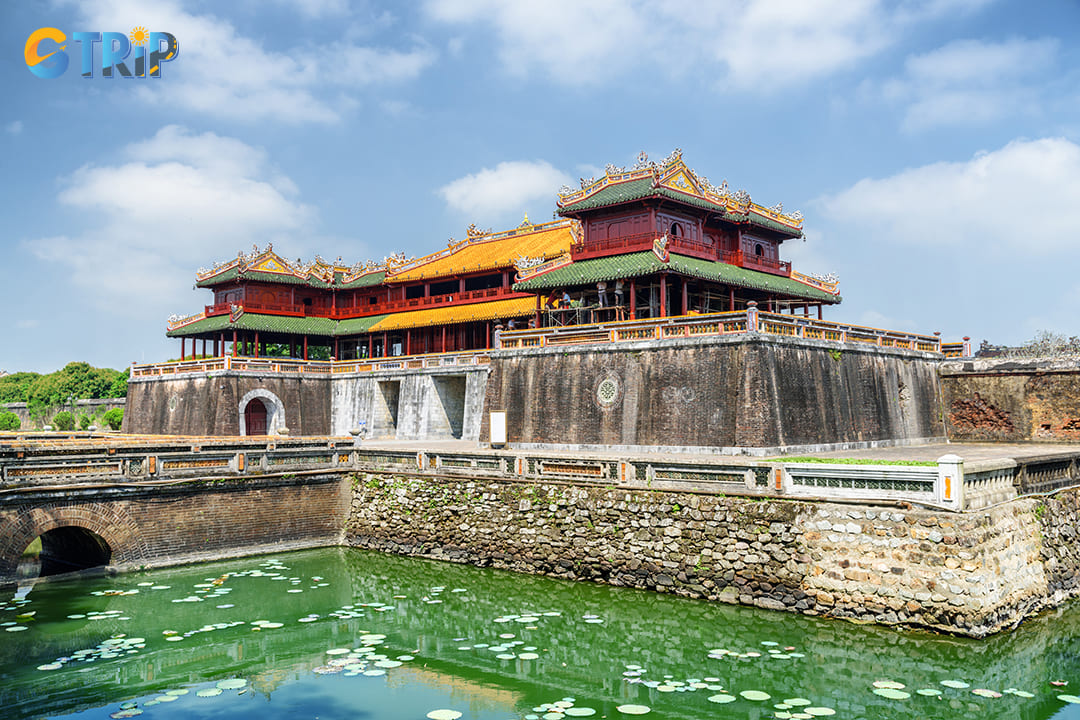
The Imperial Citadel has been the focus of dedicated restoration projects
Things to do at the Imperial Citadel of Hue
The Imperial Citadel of Hue offers a variety of activities for visitors to engage with its rich history and cultural heritage. Here are some of the top experiences to consider:
1. Walk through the majestic Ngo Mon Gate
Begin your journey into the Imperial City by stepping through the legendary Ngo Mon Gate, the main southern entrance and the most important ceremonial gate of the entire Hue Citadel. Built in 1833 during the reign of Emperor Minh Mang, this gate was the main ceremonial gateway to the imperial grounds. Its distinctive five-arched structure carries profound symbolic meaning: only the emperor could pass through the central arch, while mandarins, soldiers, and royal family members used the side passages. The design reflects the Confucian ideals of order and hierarchy that shaped the Nguyen Dynasty’s rule. Flanked by sturdy stone walls and set above a large courtyard, Ngo Mon Gate served as a formal threshold separating the outside world from the royal domain.
Above the central passage sits the Pavilion of Five Phoenixes, a two-tiered structure with a richly decorated roof. This is where emperors once appeared to address the court or preside over important ceremonies. Built with traditional materials like wood, stone, and imperial yellow-glazed tiles, the gate showcases elegant dragon motifs, phoenix symbols, and intricate carvings representing power and divine protection. This was not just an entryway, it was a stage for imperial authority. Today, you can walk where emperors once stood, admire the harmonious blend of architecture and symbolism, and gain a deeper understanding of Vietnam’s royal heritage.
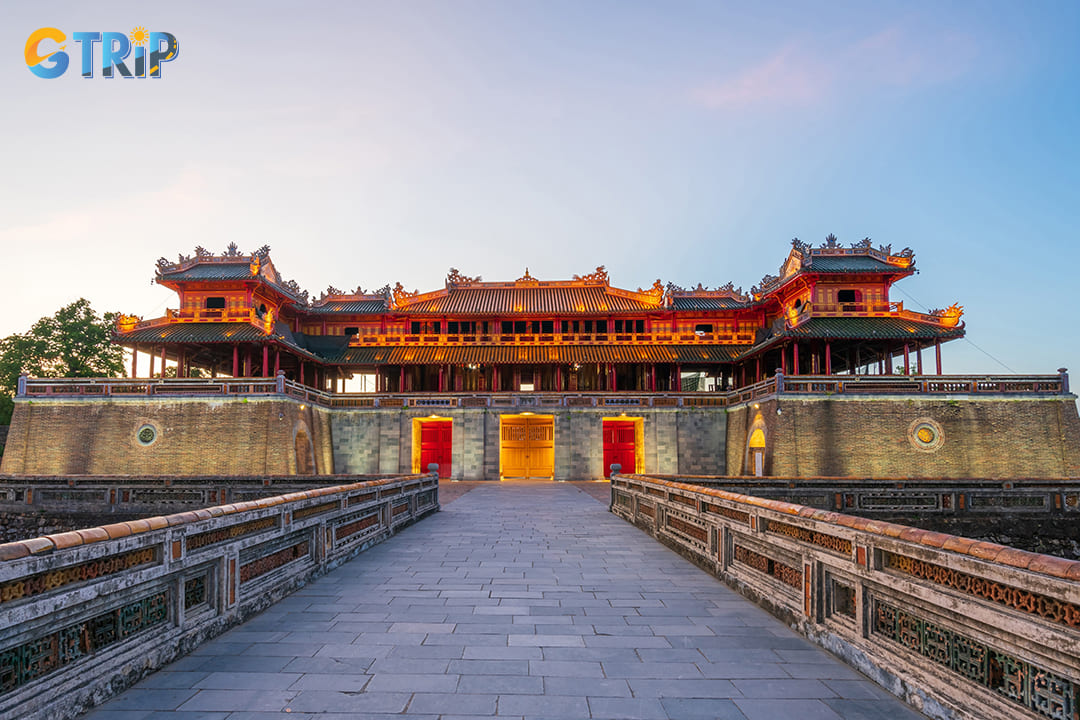
Ngo Mon Gate was the main ceremonial gateway to the imperial grounds
2. Visit the Imperial City (Hoang Thanh)
Step beyond the Ngo Mon Gate and enter the Imperial City (Hoang Thanh), the political and ceremonial heart of the Nguyen Dynasty. Enclosed within formidable stone walls and surrounded by a moat, this rectangular complex spans over 37 hectares. It was meticulously planned to reflect Confucian principles of harmony, hierarchy, and order. The Imperial City served as the seat of government, the location of key state rituals, and the residence of high-ranking officials. Its layout follows a strict axial design, aligned north-south, with palaces, temples, and courtyards arranged symmetrically.
As you wander through its expansive grounds, you’ll encounter some of the most iconic structures of imperial Vietnam:
- Thai Hoa Palace (Palace of Supreme Harmony): The ceremonial throne hall, where emperors conducted official audiences and hosted foreign delegations. The palace’s double-tiered roof, supported by elaborately carved lacquered pillars, features golden dragons and phoenixes, symbols of authority and virtue. Step inside to view the restored throne and learn about royal court protocols that once dictated every movement in this sacred space.
- Dien Tho Residence: This elegant and serene complex housed the Queen Mother, offering a rare glimpse into the private life of the imperial family. Its refined layout includes living quarters, gardens, and ancestral shrines, all designed with understated elegance and built for comfort and spiritual tranquility.
- Hien Lam Cac (Hien Lam Pavilion): A three-story wooden tower built to honor the merits of past emperors and mandarins. This structure serves as both a historical monument and an architectural marvel, with symmetrical lines and ornate wooden details reflecting the dynasty’s reverence for loyalty and service.
The Imperial City’s architecture reflects the height of Vietnamese royal design, blending rich symbolism, feng shui principles, and traditional craftsmanship. Intricate wooden carvings, vibrant lacquer work, and imperial tile roofs demonstrate the cultural sophistication of the Nguyen court. Exploring Hoang Thanh offers visual splendor and also a deeper understanding of Vietnam’s dynastic legacy and the daily life behind the royal walls.
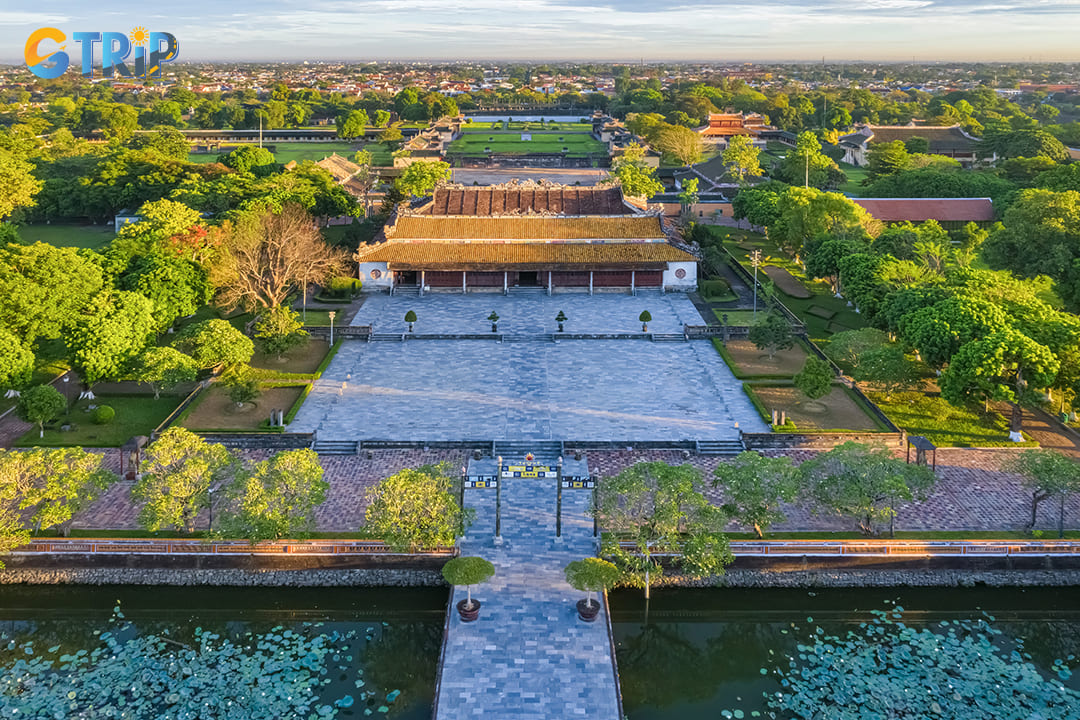
The Imperial City served as the seat of government, the location of key state rituals, and the residence of high-ranking officials
3. Discover the Forbidden Purple City
At the very heart of the Imperial Citadel lies the Forbidden Purple City (Tu Cam Thanh), the most exclusive and private area of the Nguyen Dynasty’s royal compound. Inspired by China’s Forbidden City in Beijing, this inner sanctum was strictly off-limits to all but the emperor, his immediate family, and selected palace servants. Spanning over 9 hectares, the Forbidden Purple City was surrounded by high brick walls and accessed through only a few guarded gates, ensuring the utmost secrecy and security for royal life. It was both a residence and a center for intimate court affairs, embodying the refined, secluded world of Vietnam’s monarchy.
As you explore the remaining structures and foundations, you can envision the rhythms of life behind the veil of royal privacy. Key landmarks include:
- Can Chanh Palace: The emperor’s main living and working quarters, where he attended to state matters in private.
- Khon Thai Palace: Residence of the queen, reflecting the status and role of the empress in court life.
- Duyet Thi Duong (Royal Theatre): One of Vietnam’s oldest court theaters, where emperors and their families enjoyed classical music, poetry, and performances by imperial artists.
- Thuong Thien Palace (Imperial Kitchen): The culinary heart of the royal compound, where meals were prepared with exacting standards for the emperor and his family.
Though many of the original structures were damaged or lost due to war and time, restoration efforts continue to revive this historic space. As you walk through its quiet courtyards and view the remaining pavilions and ceremonial paths, you’ll gain a rare glimpse into the emperor’s daily life, marked by rituals, aesthetics, and strict protocol. The Forbidden Purple City reveals the private world of royalty and also the depth of imperial Vietnam’s cultural sophistication.
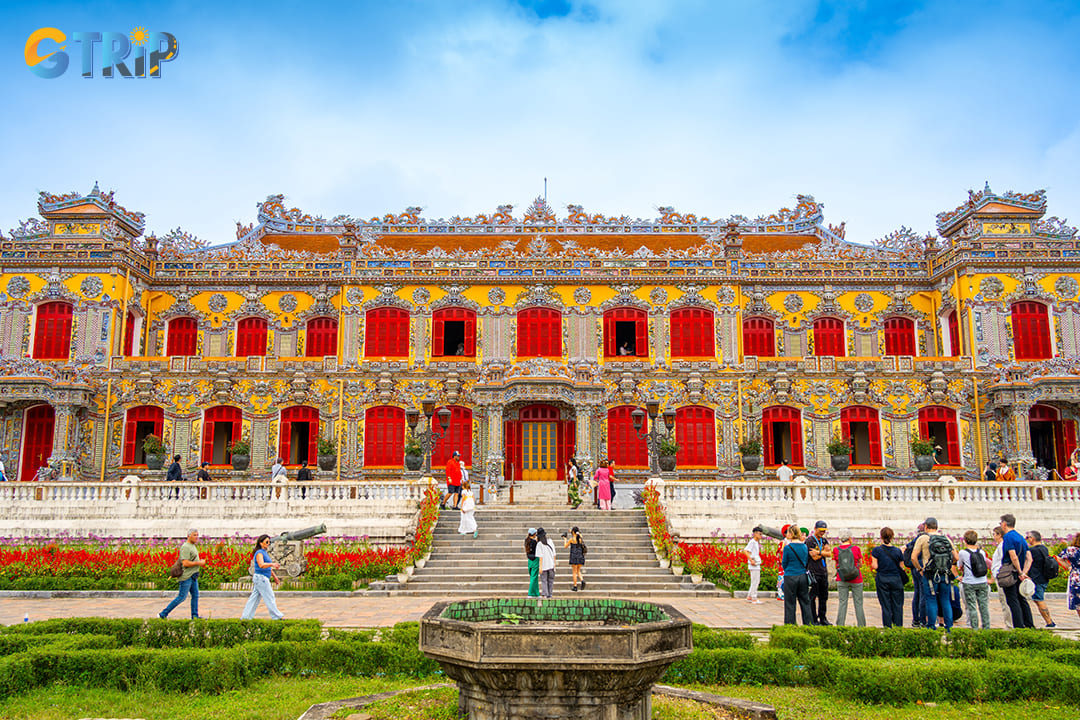
At the very heart of the Imperial Citadel lies the Forbidden Purple City, the most exclusive and private area of the Nguyen Dynasty’s royal compound
4. Stroll through the citadel’s gardens and moats
Surrounding the Imperial Citadel is a peaceful landscape of moats, lotus ponds, and lush gardens that soften the fortress’s grandeur. Originally built for defense, the moats now add to the site’s serene beauty, with arched stone bridges and calm waters reflecting the royal architecture. Inside, tree-lined paths and quiet courtyards follow feng shui principles, creating balance between nature and structure. These green spaces were once retreats for emperors seeking rest and reflection, and today they offer you a tranquil escape in the heart of Hue’s imperial legacy.
5. Take a guided night tour
The Night Tour of the Imperial City (Tour Dai noi ve dem) in Hue offers a magical journey into the heart of Vietnam’s royal past. Taking place nightly from 7:00 PM to 10:00 PM, this experience allows guests to admire the former royal complex bathed in warm, atmospheric lighting. Tickets are priced at 150,000 VND, with 50% discounts available for those who visited the citadel during the day or for local residents. This is not just a night walk, it’s a multi-sensory immersion into the elegance and mystery of the Nguyen Dynasty.
As you explore, the citadel transforms under the lights. Landmarks such as Ngo Mon Gate, Trung Dao Bridge, Thai Dich Lake, Thai Hoa Palace, and the long corridors of the Forbidden Purple City become even more breathtaking. The tour features a range of engaging activities that blend performance, heritage, and hands-on experience:
- Witness royal rituals like the ceremonial changing of the guards, and enjoy the resonant sounds of Dai nhac (Great Music) and Tieu nhac (Chamber Music) performed live.
- Experience court life through martial arts displays, royal dances, and imperial-themed games.
- Visit special exhibitions about Hue’s five UNESCO-recognized heritage sites and rotating cultural displays within historic buildings.
- Try traditional crafts at Phu Noi Vu, Dien Tho Palace, and Truong Sanh Palace, where you can observe and interact with artisans.
- Enjoy a tea ceremony in the Dien Tho Palace garden, offering a peaceful moment in an authentic royal setting.
- Access select sites for free on special evenings, including Thieu Phuong Garden and Phu Noi Vu.
- Watch the ceremonial cannon firing at Ky Dai Flag Tower, held every Saturday at 7:15 PM, evoking the power and pageantry of the Nguyen court.
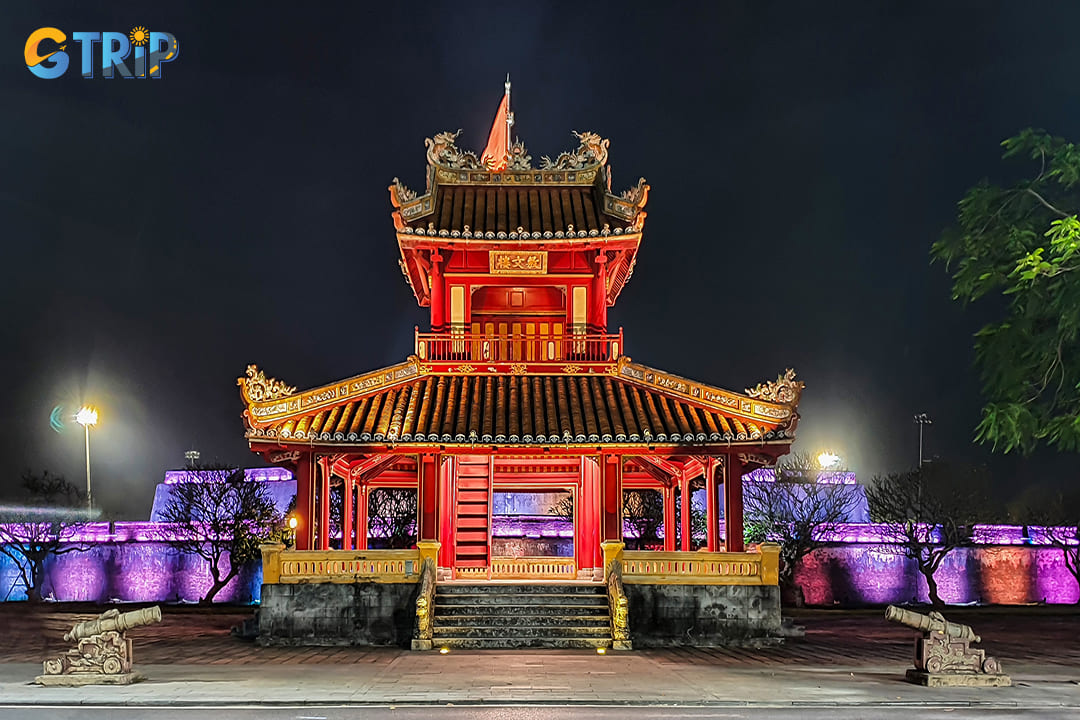
The Night Tour of the Imperial City (Tour Dai noi ve dem) in Hue offers a magical journey into the heart of Vietnam’s royal past
6. Ride a cyclo around the citadel
Exploring the Imperial Citadel by cyclo (pedicab) is a charming and comfortable way to take in the grandeur of this historic site. As you relax in the seat of a traditional three-wheeled vehicle, your local driver pedals you past ancient gates, shady boulevards, and tranquil lotus ponds at a slow, scenic pace. It’s an ideal option for those who want to cover more ground without tiring and a great opportunity to hear personal stories or insights from the drivers, many of whom have lived in Hue their entire lives. A cyclo ride offers not just convenience, but a nostalgic cultural experience that brings the soul of the city to life.
7. Learn about the history and culture
Inside the Imperial Citadel, several temples and shrines offer a deeper look into the spiritual and cultural life of the Nguyen Dynasty. These sacred spaces, dedicated to emperors and royal ancestors, reflect the Confucian principles that shaped the court’s values and governance. As you wander through places like the The Mieu Temple or Hung Mieu Shrine, you’ll gain insight into the rituals, ancestor worship, and ceremonial traditions that once defined imperial Vietnam. The detailed altars, incense-filled halls, and symbolic architecture speak volumes about the reverence held for heritage and the legacy of the Nguyen rulers.
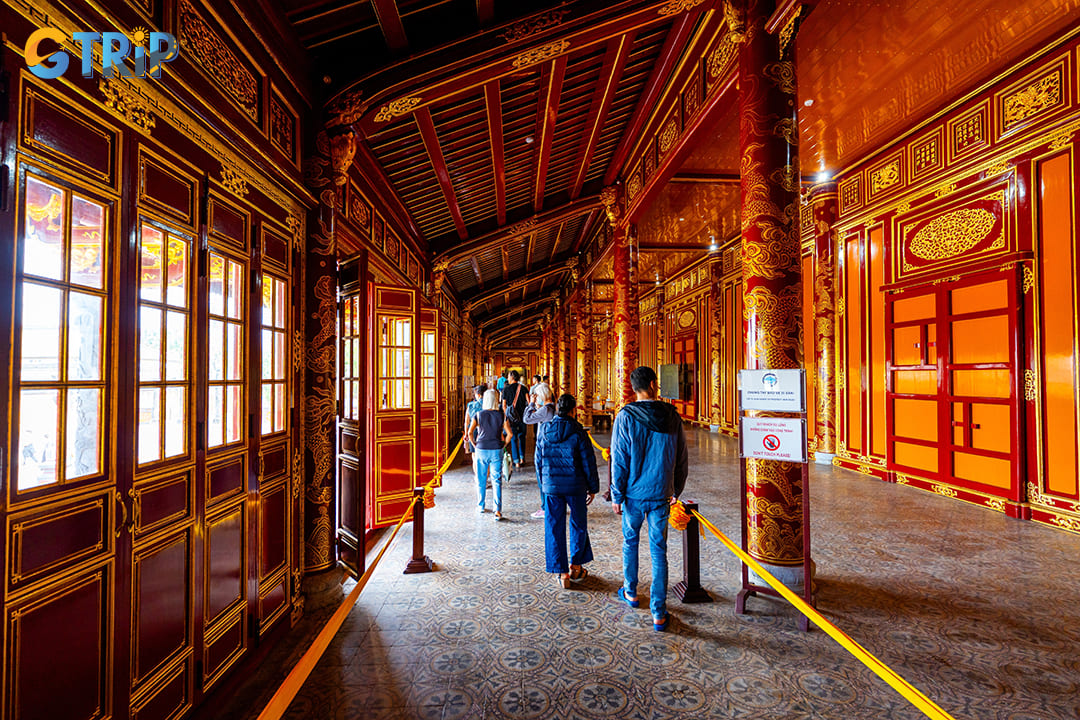
Inside the Imperial Citadel, several temples and shrines offer a deeper look into the spiritual and cultural life of the Nguyen Dynasty
8. Attend a cultural performance at Duyet Thi Duong theatre
Duyet Thi Duong Royal Theatre is one of the oldest surviving court theatres in Vietnam and a rare opportunity to witness the elegance of traditional performance arts in an authentic setting. Attending a show here immerses you in the artistic world of the Nguyen Dynasty, where music, dance, and drama were integral to royal life. These cultural performances feature imperial court music (Nha Nhac), graceful royal dances, and theatrical reenactments that reflect the sophistication of the former imperial court. With its restored wooden architecture and ceremonial ambiance, the theatre adds a rich, historical layer to your visit and offers a memorable glimpse into Vietnam’s royal cultural heritage.
9. Experience the Hue Festival year-round
Unlike most cities that host festivals only once a year, Hue brings its imperial charm to life year-round through a vibrant series of seasonal festivals. Known as the Hue Festival - Four Seasons, this year-round celebration transforms the ancient capital into a dynamic cultural hub. Each season brings a unique theme that showcases Hue’s rich history, time-honored traditions, and vibrant artistic spirit.
- Spring Festival - “Spring in the Imperial Capital” (January to March): Celebrate traditional Vietnamese New Year with royal-style rituals, folk performances, and colorful cultural spaces that showcase the festive spirit of Hue’s heritage.
- Summer Festival - “The Shining Citadel” (April to June): The most anticipated time of the year, featuring the Hue International Arts Festival Week, where both local and international artists perform traditional and contemporary shows at heritage venues like the Imperial City and along the Perfume River.
- Autumn Festival - “Autumn in Hue” (July to September): Centered around the Mid-Autumn Festival, this season comes alive with lantern parades, lion and dragon dances, cultural exhibitions, and hands-on experiences that celebrate childhood and Vietnamese folklore.
- Winter Festival - “Winter in Hue” (October to December): End the year with warmth and excitement through the Hue Music Week and the festive New Year’s Countdown, filling the cold months with music, lights, and joyful gatherings.
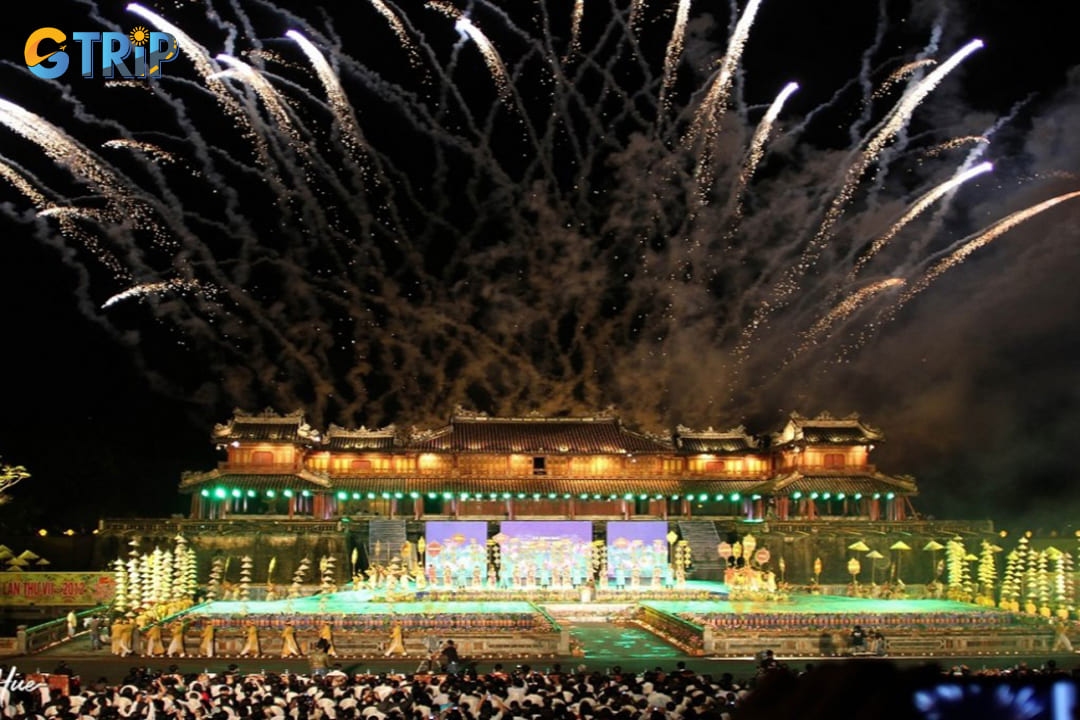
Hue brings its imperial charm to life year-round through a vibrant series of seasonal festivals
Ticket prices and opening hours of the Imperial Citadel of Hue
Tourists to the Imperial Citadel of Hue can expect clear and structured ticket pricing that applies equally to both Vietnamese and international tourists. The ticket system includes individual site tickets, combined route tickets, and optional guided tour fees, all updated as of January 1, 2023, with guided tour prices effective from January 1, 2024. Tickets can be purchased at entrance gates such as Ngo Mon Gate or online via official platforms and local travel apps.
Individual ticket prices (Valid from 01/01/2023)
| Attraction | Adult price (VND) | Child price (7 - 12 years) (VND) |
|---|---|---|
| Imperial Citadel (Dai Noi Hue) | 200,000 | 40,000 |
| Tombs of Emperors Minh Mang, Tu Duc, Khai Dinh | 150,000 | 30,000 |
| Tomb of Emperor Gia Long | 150,000 | Free |
| Tomb of Emperor Dong Khanh | 100,000 | Free |
| Other sites: Tomb of Emperor Thieu Tri, Hue Royal Antiquities Museum, Hon Chen Temple, An Dinh Palace, Nam Giao Esplanade | 50,000 | Free |
Combined route ticket prices (Valid from 01/01/2023)
| Route description | Adult price (VND) | Child price (7 - 12 years) (VND) |
|---|---|---|
| Minh Mang Tomb + Gia Long Tomb | 240,000 | 30,000 |
| Tu Duc Tomb + Dong Khanh Tomb | 200,000 | 30,000 |
| Hue Royal Antiquities Museum + An Dinh Palace | 80,000 | Free |
| Dai Noi Hue + Minh Mang Tomb + Khai Dinh Tomb | 420,000 | 80,000 |
| Dai Noi Hue + Minh Mang Tomb + Tu Duc Tomb | 420,000 | 80,000 |
| Dai Noi Hue + Tu Duc Tomb + Khai Dinh Tomb | 420,000 | 80,000 |
| Dai Noi Hue + Minh Mang Tomb + Tu Duc Tomb + Khai Dinh Tomb | 530,000 | 100,000 |
Note: Children under 6 years old are admitted free to all sites.
Guided tour prices (Effective from 01/01/2024)
| Site | Guided tour fee (VND per ticket) |
|---|---|
| Imperial Citadel | 200,000 |
| Tu Duc Tomb | 150,000 |
| Khai Dinh Tomb | 150,000 |
| Minh Mang Tomb | 150,000 |
Guided tour fees apply equally to domestic and international visitors.
Opening hours
The visiting hours for the Imperial Citadel of Hue vary by season to suit the weather and daylight conditions:
Summer (March 16 - October 15):
- Open from 6:30 AM to 6:00 PM
- Ticket sales from 6:30 AM to 5:30 PM
Winter (October 16 - March 15):
- Open from 7:00 AM to 5:30 PM
- Ticket sales from 7:00 AM to 5:00 PM
To make the most of your visit and explore the full complex without rushing, it’s recommended to arrive early in the day.
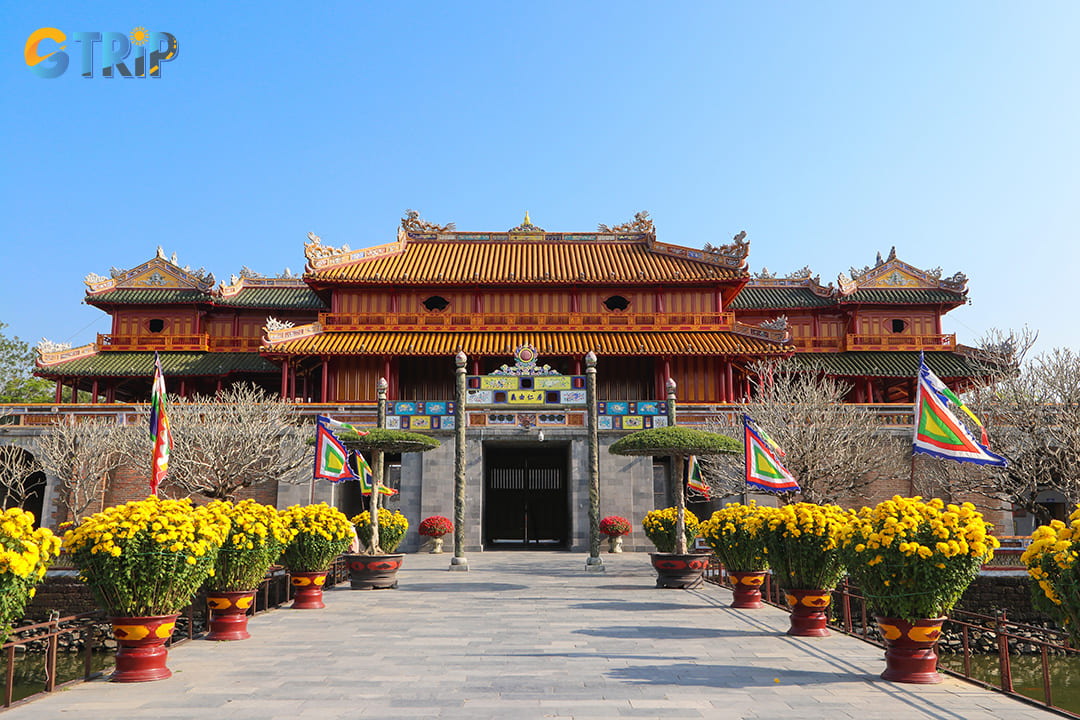
The visiting hours for the Imperial Citadel of Hue vary by season to suit the weather and daylight conditions
Best time to visit the Imperial Citadel of Hue
The best time to explore the Imperial City is during the dry season (March to August), when the weather is warm and sunny. It is perfect for walking through the vast complex without interruption from rain. This period also coincides with the Hue Festival (April to June), which brings the citadel to life with cultural performances, exhibitions, and traditional games.
For a quieter and more romantic experience, consider visiting in the rainy season (September to February). Though there may be tropical showers, the citadel takes on a peaceful, misty charm with fewer crowds. January and February are particularly pleasant, with mild weather and a calm atmosphere. Local tours are also adapted for the rain, including shaded walks and covered cyclo rides.
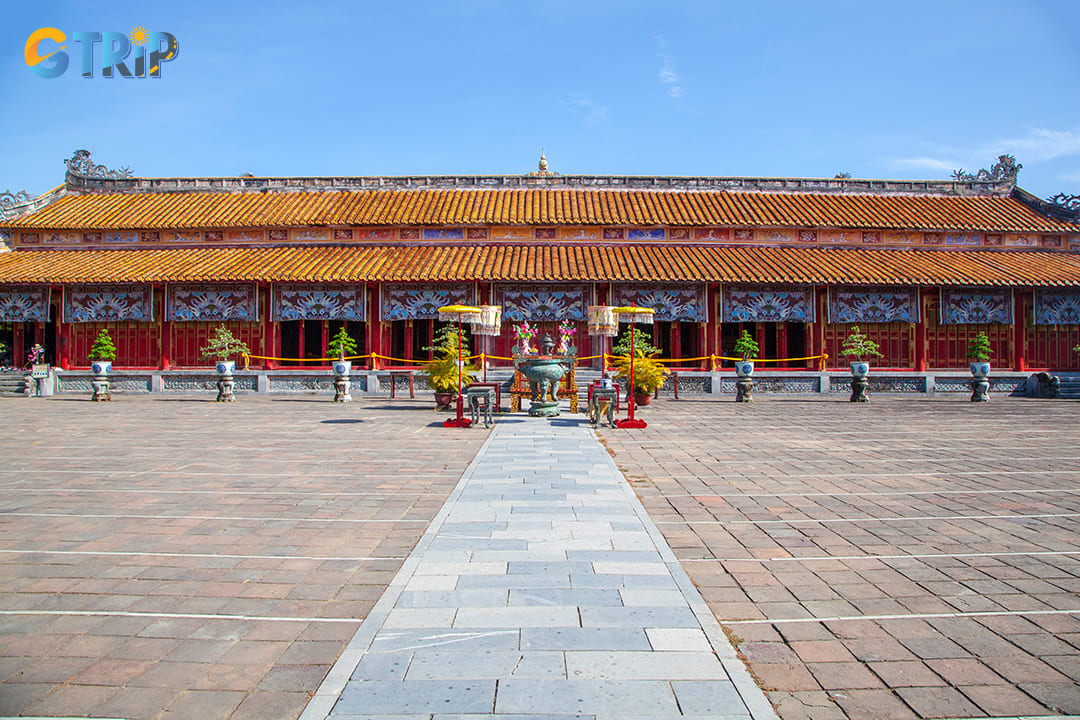
The best time to explore the Imperial City is during the dry season when the weather is warm and sunny
How to get to the Imperial Citadel of Hue?
Reaching the Imperial Citadel of Hue is relatively straightforward, with several transportation options available depending on your starting location. Here's a guide to help you plan your journey:
From Hue airport (Phu Bai International Airport)
- Taxi: The most convenient option is to take a taxi from Hue Airport to the Imperial Citadel of Hue. The journey takes about 15 minutes and costs between 230,000 to 300,000 VND (approximately $9 to $12). You can use services like Vinasun Taxi, Malinh Taxi Group, or Grab Taxi.
- Ride-hailing apps: Ride-hailing apps like Grab, Be offer a similar price and convenience, allowing you to book directly from your phone. Its service costs between 200,000 to 360,000 VND (approximately $8 to $13.83) for the same duration.
From Ho Chi Minh City
- Flight: The fastest way to get from Ho Chi Minh City to Hue is by flying from Tan Son Nhat International Airport to Phu Bai International Airport. The flight takes about 2 hours and 45 minutes, with prices ranging from 1,100,000 to 3,200,000 VND (approximately $43 to $124).
- Train: You can also take the train, which involves a transfer in Da Nang. The total journey time is approximately 22 hours and 34 minutes. The cost is between 2,000,000 and 4,000,000 VND (approximately $78 to $155).
- Bus: Taking the bus is another option, with a journey time of around 23 hours, costing between 400,000 and 500,000 VND (approximately $16 to $20).
From other locations in Hue
- Walking: If you are staying in the central area of Hue, walking to the Hue Imperial City is a viable option. This place is located near the Perfume River, and walking along the riverbank can be a pleasant way to arrive.
- Cyclo or taxi: For those who prefer not to walk, hiring a cyclo or taking a short taxi ride from your hotel is easy and inexpensive. Cyclo rides typically cost around 50,000 to 100,000 VND (approximately $2 to $4). Taxi fares are about 20,000 to 50,000 VND (approximately $1 to $2).
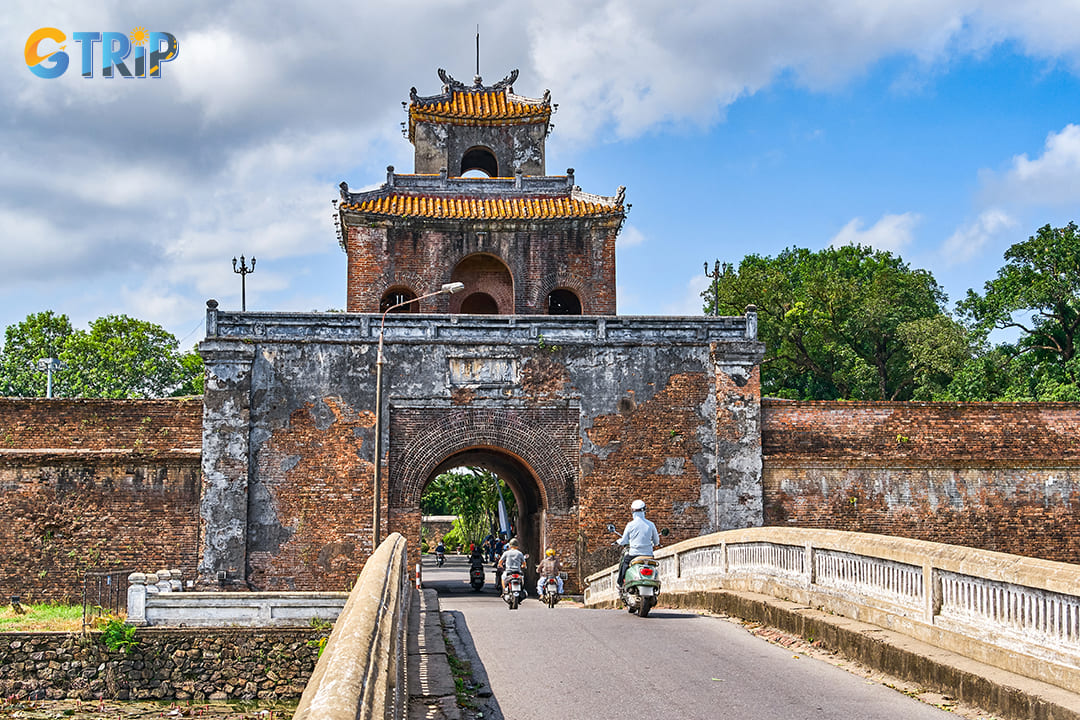
Reaching the Imperial Citadel of Hue is relatively straightforward
Other Hue’s royal tombs to explore
Exploring the Imperial Citadel of Hue is incomplete without visiting the other royal tombs, which offer a deeper understanding of the Nguyen Dynasty's legacy. These tombs, located along the picturesque banks of the Perfume River, are resting places for emperors and architectural masterpieces reflecting Vietnam's historical grandeur. Below are the significant royal tombs you can explore.
Emperor Tu Duc's Tomb (around 7.7 km)
Constructed between 1864 and 1867, Tu Duc's Tomb is one of the most beautiful and romantic tombs in Hue. The complex resembles a vast park with serene lakes, lush greenery, and tranquil pavilions, showcasing Emperor Tu Duc’s love for nature and poetry. The tomb is divided into two main areas: the temple area and the tomb area. You can explore its intricate carvings, picturesque landscapes, and poetic ambiance that reflect the emperor’s literary interests. Located in Thuy Xuan Ward, it is open daily from 7:30 AM to 5:30 PM, with an entrance fee of 150,000 VND for adults and 30,000 VND for children, according to the official website.
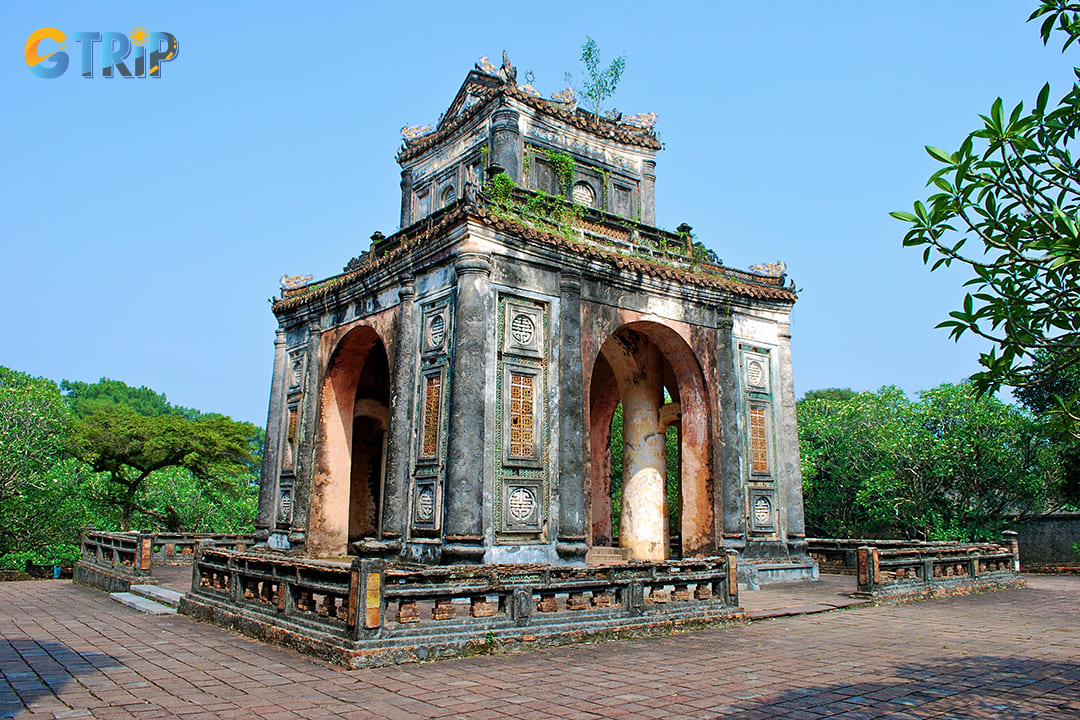
Tu Duc's Tomb is one of the most beautiful and romantic tombs in Hue
Emperor Minh Mang's Tomb (around 13.8 km)
Known for its symmetry and majesty, Minh Mang's Tomb is one of the most architecturally impressive royal mausoleums. Built posthumously between 1843 and 1849, this tomb emphasizes Confucian ideals with nearly 40 constructions symmetrically arranged along a central axis. The layout harmonizes with its natural surroundings, including gardens and lakes that create a serene atmosphere. Minh Mang’s Tomb opens daily from 7:00 AM to 5:30 PM, with an entrance fee of 150,000 VND for adults and 30,000 VND for children, according to the official website.
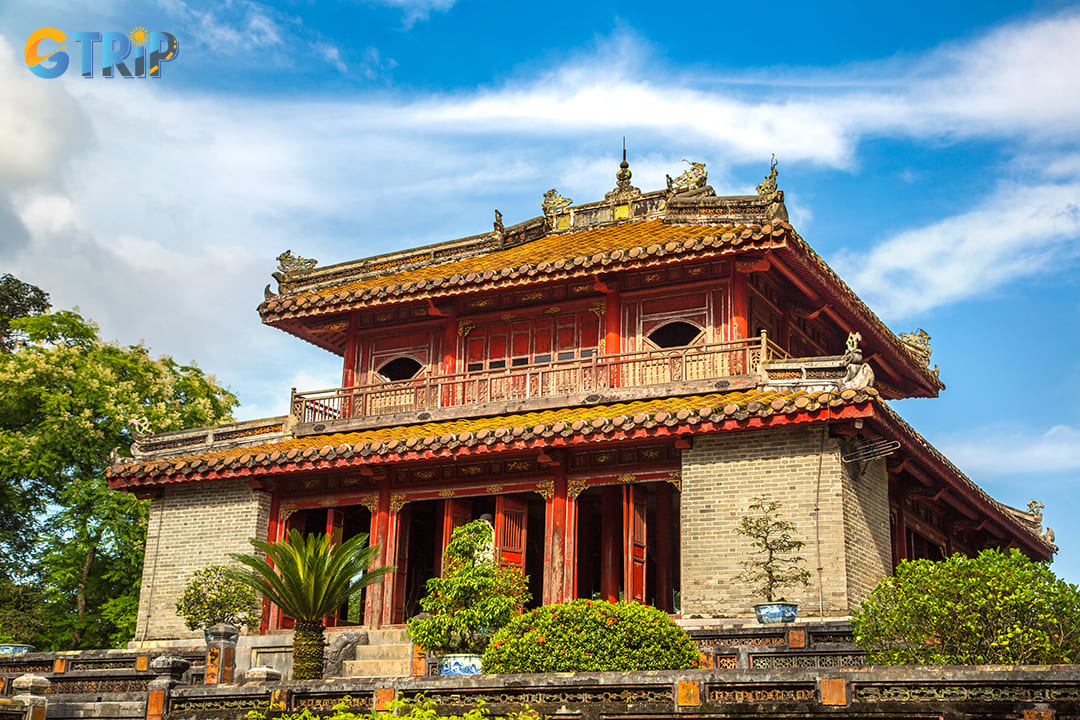
Minh Mang's Tomb is one of the most architecturally impressive royal mausoleums
Emperor Khai Dinh's Tomb (around 10.7 km)
Completed in 1931 after 11 years of construction, Khai Dinh's Tomb stands out for its flamboyant blend of Vietnamese and European architectural styles. It is smaller than other tombs but highly ornate, featuring intricate glass and porcelain mosaics that reflect Emperor Khai Dinh’s modern taste influenced by French colonialism. The tomb is situated on Chau Chu Mountain in Thuy Bang Commune and is open daily from 7:00 AM to 5:00 PM. Entrance fees are 150,000 VND for adults and 30,000 VND for children, according to the official website.
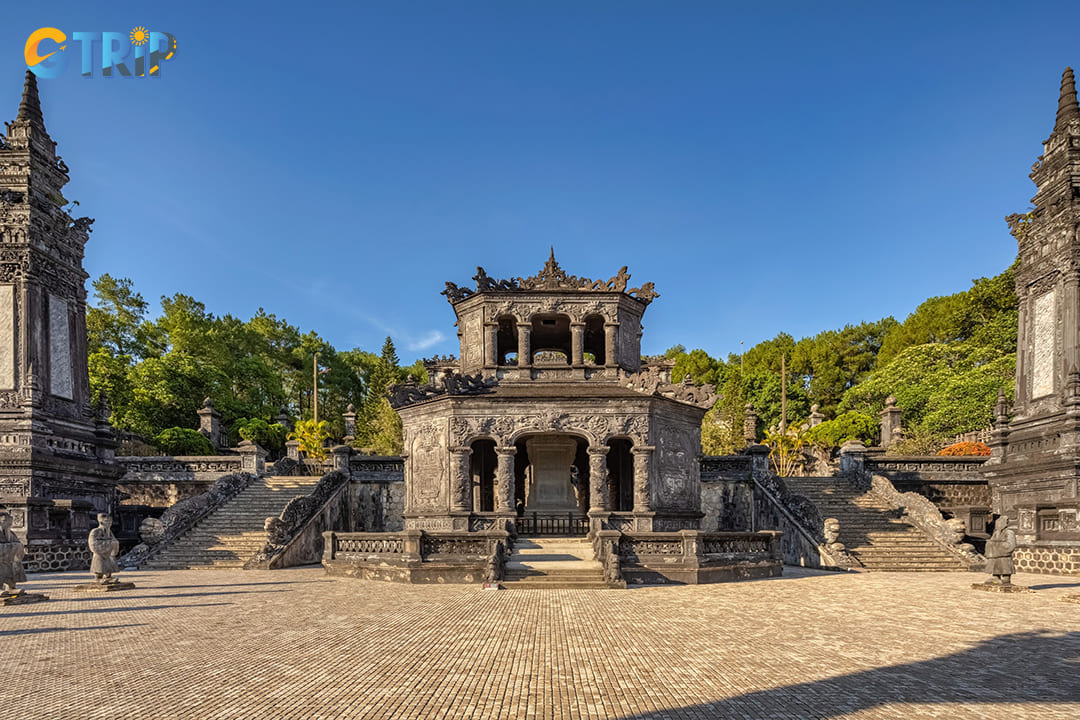
Khai Dinh's Tomb stands out for its flamboyant blend of Vietnamese and European architectural styles
Travel tips when visiting the Imperial Citadel of Hue
To make the most of your visit to the Imperial Citadel of Hue, here are some additional travel tips:
- Wear traditional clothing for photos: Renting traditional Vietnamese attire can enhance your experience and create unique photo opportunities that reflect the cultural ambiance of the citadel.
- Hire a professional photographer: Consider booking a private photography tour for personalized guidance, high-quality equipment, and exclusive access to top spots within the citadel.
- Respect photography rules: Certain areas, like Thai Hoa Palace, may have restrictions on photography; always check signage and follow guidelines.
- Visit during festivals: Plan your trip around events like the Hue Festival to enjoy cultural performances and exhibitions that bring the citadel to life.
- Stay hydrated: the expansive grounds can take several hours to explore, so bring bottled water to stay refreshed during your visit.
- Use a map or guide: The citadel spans over 500 hectares with 13 gates; using a map or hiring a guide can help you navigate and avoid getting lost.
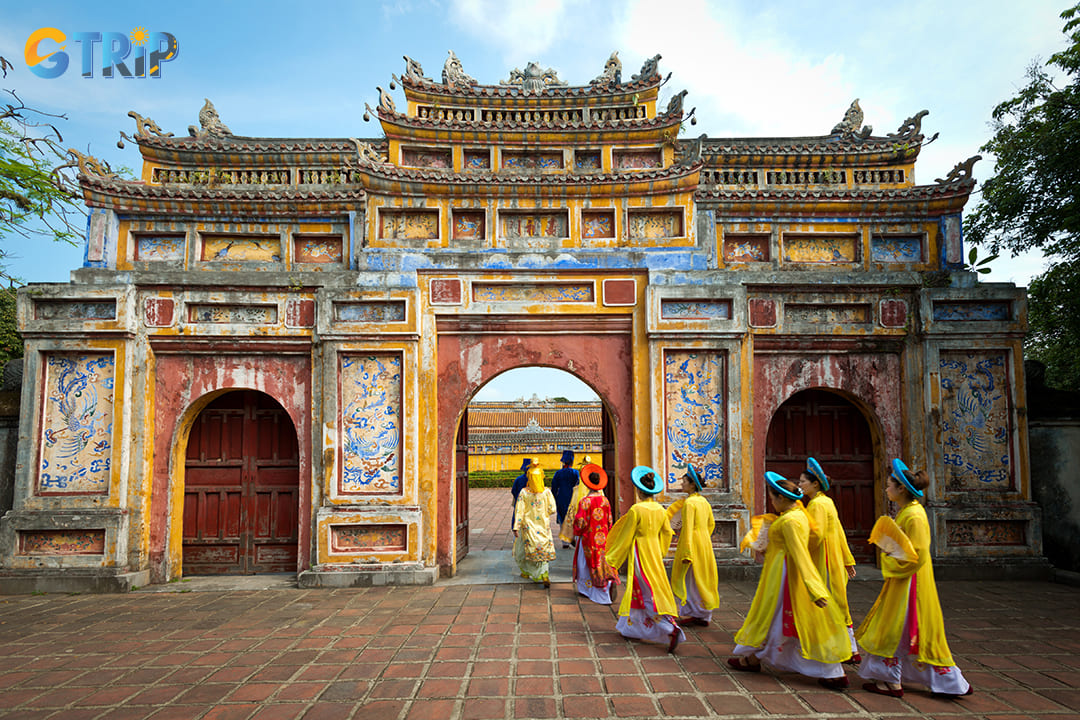
Renting traditional Vietnamese attire can enhance your experience and create unique photo opportunities
The Imperial Citadel of Hue is not just a historic site, it is a living museum that encapsulates the grandeur, traditions, and cultural depth of Vietnam’s last imperial dynasty. Every corner of the citadel tells a story that enriches your understanding of the country’s heritage, from the majestic Ngo Mon Gate to the serene royal gardens. For a seamless and insightful journey, book a guided tour to Hue with GTrip - Vietnam Travel Agency. Our expert-led tours are crafted to help you uncover the full beauty and meaning behind this UNESCO-listed treasure. Let GTrip take care of the details while you focus on experiencing the timeless charm of Vietnam’s former imperial capital.

